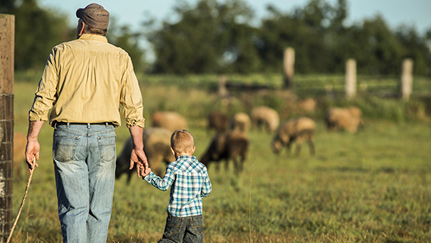Finding time to talk to your family about succession planning for your farm may be difficult. You may also be uncomfortable with the thought of selling your farm or handing over control to family members.
Make the time to develop a solid succession plan (often called a “transition plan”) for your farming business. As it transfers to its next generation of leaders, you’ll help ensure that your family’s wishes are met, and emotional stress is minimized.
What you should know up front about transitioning your farm
Unlike estate plans, which concentrate on tax liabilities and the various ways to lessen the tax burden, transition plans focus on the future of the farm. They’re an integral part of an estate farm plan.
When you decide to retire, your farm succession plan may include:
- Transferring or selling ownership to a vested family member. To be fair to non-farming heirs, you may leave them with equal settlements of money, stock or other assets.
- Liquidating farm assets, such as auctioning equipment and livestock or selling land.
- Renting or leasing your land and equipment.
- Selling or contracting the property.
Determine the desired end result
Concentrate on the desired final outcomes of the transition. Among the important questions, you should ask yourself:
- What do my spouse and I envision for the future of the farm?
- Do I want to stay involved with the operation on a smaller scale?
- What kind of income might I need for retirement or health care costs?
If you have a family member who could and may want to take over the operation, you should be comfortable that they have the knowledge and skills to run it profitably. Also, think about siblings who might each want a piece of the farm. Are you being pressured to sell by those who don’t share your love of the land?
Getting it right the first time
Transition plans sometimes fail because certain risks were not considered during the planning stages, including:
- Inadequate cash flow
- Liquidation of some assets to provide for retirement
- Poor farm estate planning
- Unresolved issues between family members or a successor who’s not prepared to lead and manage the farm business
It’s important to enlist the help of qualified professionals who don’t have a stake in the final decisions. They can help you make sound, unbiased decisions for your farm estate. Qualified professionals may include:
- A financial or estate planner who specializes in farm estate planning
- A moderator or arbitrator to help with family discussions
- Your banker to help with finance resources
- Your accountant who has income records and projections for your business
- Your personal attorney, or one who specializes in tax issues
You can also trust Nationwide to help guide you throughout the entire transition planning process. Learn more about our Land As Your Legacy® program.
Nationwide is a proud sponsor of Annie’s Project, bringing financial and business education programs to women in agribusiness.
